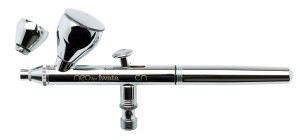 AIR-CRAFT.NET is based in Fort William and provides premium airbrushing, graphic equipment, craft tools and associated materials to graphic artists, crafter and scale modellers and general air brushers.
AIR-CRAFT.NET is based in Fort William and provides premium airbrushing, graphic equipment, craft tools and associated materials to graphic artists, crafter and scale modellers and general air brushers.
Our portfolio of quality products consists only of recognised and quality articles in these fields, the vast majority of which are purchased direct from the manufacturers and imported directly when required. As a consequence we only advertise items which we regularly have in stock.
We have a detailed FAQ page for our customers (and customers-to-be) but have decided to provide more helpful hints and tips on our products and their use through the Blog, and thought we’d begin with the basics.
How do airbrushes work?
Here’s the theory. An airbrush relies on the Venturi effect to draw paint (or any other medium) into a fast moving flow of air, where the paint is then atomised into a fine spray. The Venturi effect is the reduction in fluid pressure that results when a fluid flows through a constricted section (or choke) of a pipe and is named after the Italian physicist Giovanni Battista Venturi (1746–1822).
The fine spray created is then projected by the flow of fast moving air until it reaches the surface being painted.
How exactly do airbrushes work?
Here’s the practical, which applies to the most popular double action type airbrushes. When the airbrush trigger is pressed, air from the air valve is allowed to flow through the air channels in the airbrush and exits from around the outside of the nozzle tip. At this point no paint is sprayed, because the needle is still fully forward and seated against the inside of the nozzle.
As the trigger is pulled back, the needle is drawn back from the nozzle creating a circular gap around the needle tip which allows paint to flow. The paint is then drawn into and atomised by the airflow giving the resulting spray pattern, all thanks to the Venturi effect.
Comments are closed.